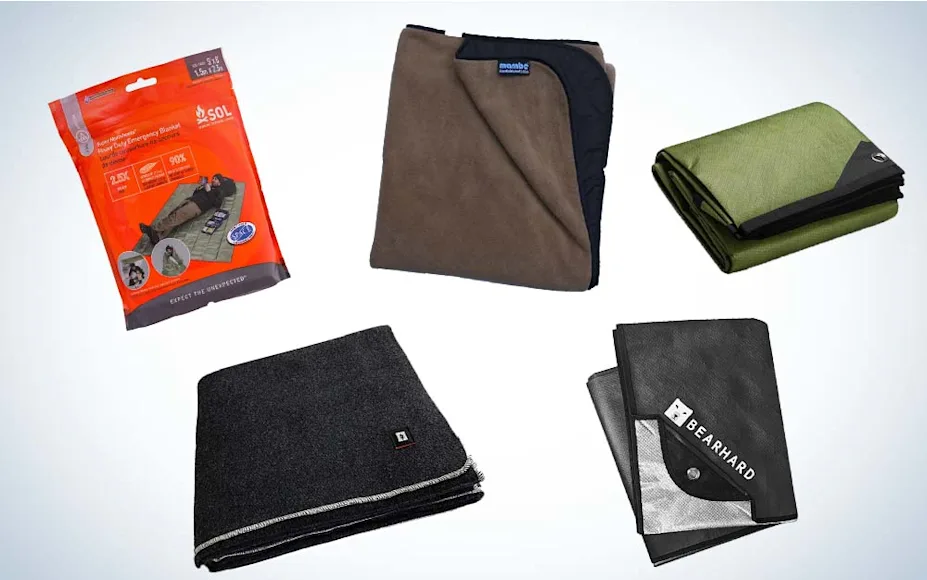_We may earn revenue from the products available on this page and participate in affiliate programs. Learn more ›
_
Best Overall

S.O.L. Heavy Duty Emergency Blanket
LEARN MORE
Summary
The S.O.L. Heavy Duty Emergency Blanket is the best overall for its ample size, durable materials, affordable price, and quality heat reflectivity.
Best for Survival
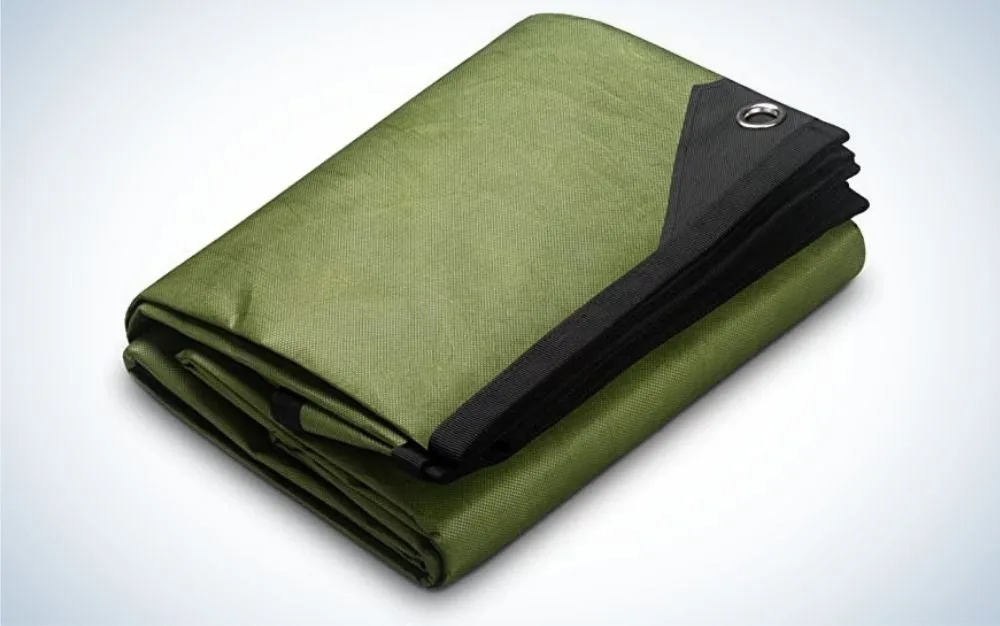
Arcturus All Weather Outdoor Survival Blanket
LEARN MORE
Summary
The Arcturus All Weather Outdoor Survival Blanket is the best for survivalists who want the benefits of both a tarp and an emergency blanket.
Best Wool
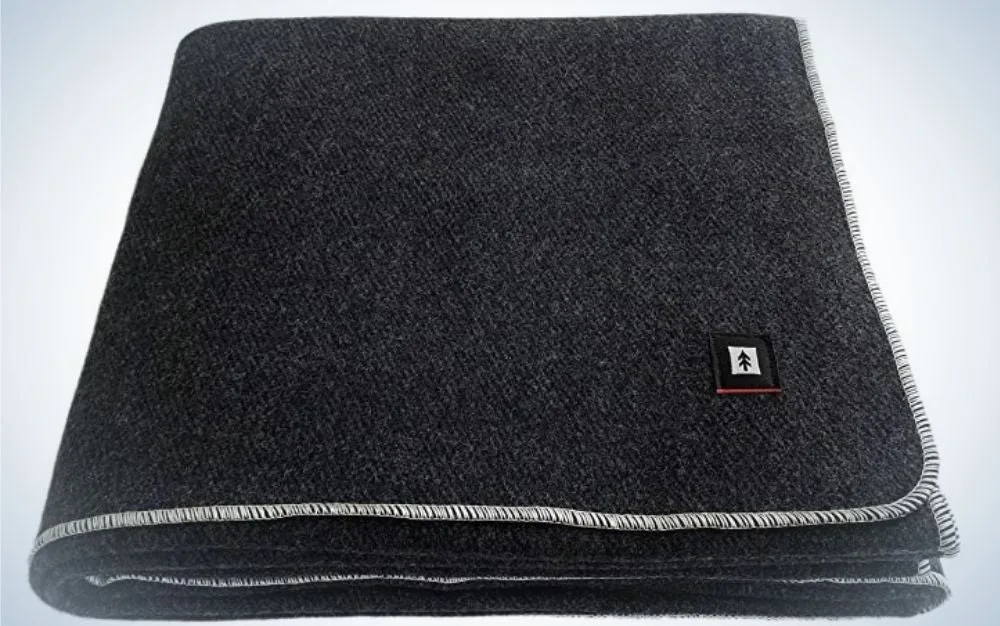
EKTOS 100% Wool Survival Blanket
LEARN MORE
Summary
If wool is more your style, the EKTOS Wool Survival Blanket is a durable, comfortable, and washable 100% wool blanket.
Having an emergency blanket in your survival kit is an excellent way to protect yourself against the elements. Whether for a car survival kit during the cold winter months or simply for ease of mind on a backpacking trip, there is a portable and practical blanket for everyone.
Unlike blankets we keep in our homes, standard emergency blankets are only intended for short-term use to preserve warmth or make shelters. These blankets won’t necessarily be cozy or all that comfortable. Their intention is to keep you alive and help you retain heat all in one portable package. Luckily, there have been some changes and innovations in the emergency blanket world to provide durable and comfortable options as well. To help you stay prepared with a well-stocked survival kit, we put together our top picks for the best emergency blankets.
Best Overall: S.O.L. Heavy Duty Emergency Blanket
Best for Hiking: Bearhard Heavy Duty Emergency Blanket
Best for Survival: Arcturus All Weather Outdoor Survival Blanket
Best Wool: EKTOS 100% Wool Survival Blanket
Best for in a Car: Mambe Large Extreme Weather Outdoor Blanket
Things to Consider Before Buying an Emergency Blanket
Before you go out and buy the first emergency blanket you see, identify your intended use and some key features of quality blankets. Read through our things to consider section to better understand what an emergency blanket is and how to pick the best emergency blanket for your needs.
Materials
From the best sleeping bags
to the best emergency blankets, materials matter. The quality and type of materials determine the overall quality, performance, durability, and often the sustainability of that product. The materials an emergency blanket is made from are somewhat narrow, and each option has its pros and cons. Traditional emergency blankets or space blankets are made from mylar, but there are a few other options too.
Mylar: most emergency blankets on the market are made from a mylar material. The use of mylar for these blankets is so widespread because they are effective in helping you retain body heat while still being extremely lightweight and affordable.
Metalized Polyester: very similar to mylar, metalized polyester has essentially the same properties. Mylar is still often more durable and tear-resistant, but they will both retain around 90% of your body heat.
Wool: potentially the second most common material used for emergency blankets is wool. Wool is a natural fiber, making it more sustainable than something like mylar. It doesn’t have the same heat reflective abilities, but wool is still an excellent insulator. They will insulate when wet and have fire retardant properties making them slightly more versatile (fiberglass cloth is also a good option for fire retardant blankets). The downside to a wool blanket is that it will be heavier, making them less convenient for something like backpacking.
Fleece: a popular midrange emergency blanket material is fleece, made from polyester or a nylon blend. Fleece tends to be affordable and relatively lightweight, but it isn’t going to have heat refection as mylar or the ability to be a fire retardant like wool.
Mylar continues to be the most popular because it is lightweight and has an affordable price. Other blanket types like wool and fleece work better for blankets you won’t have to carry very far. They are common to have in your car or RV emergency kits and home survival kits
.
Protection
Most of what we carry when we venture outdoors is for protection. When looking at the best tents
or blankets, evaluating their level of protection and the intended use is a great way to narrow down options.
Since heat retention is the primary purpose of an emergency blanket, it helps to look at that first. The best emergency blankets will be transparent about their overall performance and capabilities. Look at the materials closely because even blankets that appear to be mylar or metalized polyester can easily be knockoffs with minimal functionality in emergencies.
Other than the apparent protection from the cold, other things to look at are the water and wind resistance. Emergency blankets should at the very least still insulate when they are wet, but ideally, they would be completely waterproof. Mylar blankets are 100% waterproof, so always check the materials to ensure you purchase a material that will protect you.
When it comes to wind, the goal is to block the wind from your body and continue to help you retain heat. The best emergency blankets should protect against even the strongest winds. Materials like wool or fleece may not be as effective because they are fabrics and will allow some level of airflow through them.
The intended use of your emergency blanket will also have a lot to do with the level of protection needed. For instance, a blanket you want to bring backpacking and potentially use as a blanket or emergency shelter will likely be made from mylar for better heat retention and protection from the elements. But if you want a multi-functional blanket in your emergency car kit, a wool blanket can work just fine.
Size and Weight
Your intended use will determine a lot regarding your emergency blanket’s ideal size and weight. Do you plan to use the blanket as a shelter or want to use it for more than one person at a time? Do you need something light and small to carry while backpacking?
Ask yourself these kinds of questions, and then start to identify the size and weight to make sure the blanket will work for your needs. When it comes to size, the blanket needs to cover your body entirely. Ideally, you can wrap it around you, not just cover the front of your body. You may need a longer or wider blanket depending on if you want to use it as a groundsheet in a tent for winter camping or as a shelter in a survival kit.
The weight of a blanket has a lot to do with the materials. Mylar is the standard and an emergency blanket of average size often only weighs around 2-2.5 oz. Blankets of other materials (wool or fleece) or having several layers of material likely weigh a few pounds but can be upwards of 6 lbs. These are more suitable for in-home or vehicle survival kits.
Best Overall: S.O.L. Heavy Duty Emergency Blanket
Best Overall

Why It Made The Cut: The S.O.L. Heavy Duty Emergency Blanket is the best overall for its ample size, durable materials, affordable price, and quality heat reflectivity.
Key Features
Weight: 7.9 oz
Dimensions: 96” W x 60” L
Materials: Polyethylene
Heat Reflectivity: 90%
Pros
Multipurpose and versatile
Large size
Durable and reusable
Affordable
Cons
Hard to use as a shelter with no grommets
The S.O.L. Heavy Duty Emergency Blanket is a step up from the standard options available. It may be a few dollars more, but for that slight price difference, you get a durable blanket large enough to be used as a tent floor mat or to help insulate the top of your tent. The packability and lightweight make this blanket even better as it can easily be stowed in any emergency kit or taken into the backcountry.
Don’t let the light weight fool you, though, because this blanket also does a fantastic job helping you retain heat. With the reflective side facing your body, it has a heat reflectivity of 90 percent. For those that don’t like the loud crinkle associated with traditional space blanket designs, you will appreciate that this one is far quieter.
The blanket is durable and can be reused, which is great for those that like to use an emergency blanket often during camping trips. The only downside to this blanket design is that it does not have grommets or reinforced corners to make shelter building easy. Other than that, this is an excellent all-around blanket for outdoor and emergency situations.
Best for Hiking: Bearhard Heavy Duty Emergency Blanket
Best for Hiking
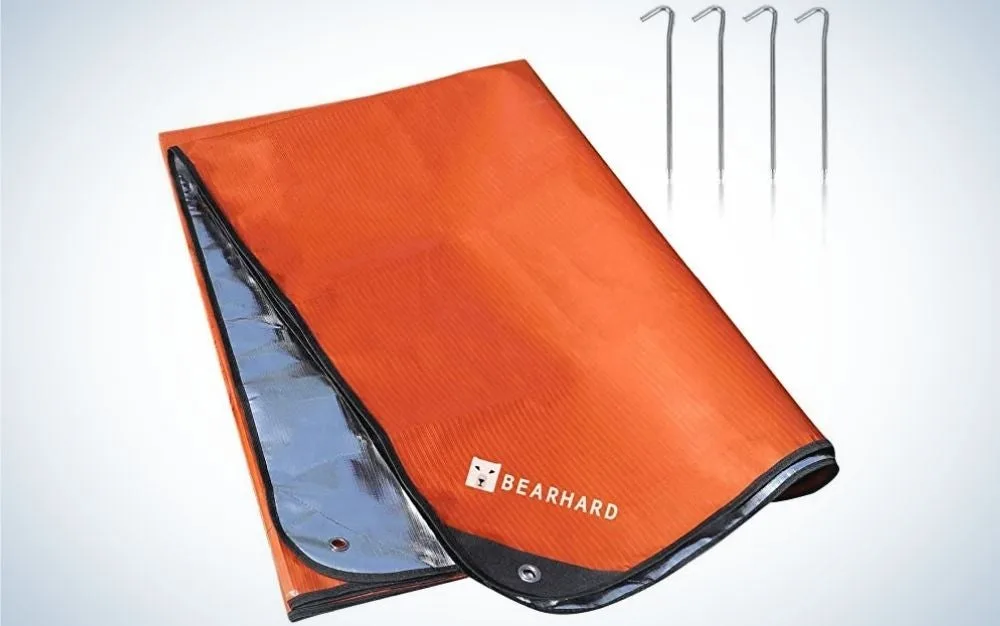
Why It Made The Cut: The Bearhard Heavy Duty Emergency Blanket is a versatile and durable camping companion that will keep you warm, dry, and more comfortable.
Key Features
Weight: 1.25 lbs
Dimensions: 84″L x 60″W
Materials: 5.0 Duralix Material
Heat Reflectivity: 90%
Pros
Multifunctional
Reinforced corners and grommets
Waterproof
5-layer material protection
Lifetime warranty
Cons
Heavier and bulkier than traditional emergency blankets
The Bearhard Heavy Duty Emergency Blanket is designed to be used in and out of emergencies. Its durable design allows you to use it as a standard piece of camping equipment. Use it as a tent footprint, backpack rain cover, emergency shelter, wind or sun block, or an emergency blanket.
The reinforced corners and grommets make it easy to set up as a shelter, and the materials provide an extra durable product. The five-layer design includes non-woven fabric, polyethylene lamination, ploy mesh, another layer of polyethylene lamination, and a layer of aluminized mylar.
The size of the blanket and the heavy-duty construction make it a bit heavier and bulkier than traditional mylar blankets. So, if you are strictly looking for an emergency blanket as a backup and not for any other function, this one may be overkill. If you like having a multipurpose item with a durable and functional construction, this is an excellent piece of gear.
Best for Survival: Arcturus All Weather Outdoor Survival Blanket
Best for Survival

Why It Made The Cut: The Arcturus All Weather Outdoor Survival Blanket is the best for survivalists who want the benefits of both a tarp and an emergency blanket.
Key Features
Weight: 3 lbs
Dimensions: 12’ L x 8.5’ W
Materials: mylar and polypropylene
Heat Reflectivity: 90%
Pros
Durable
Multifunctional
Large size
Grommets and reinforced corners
Cons
Heavy
More expensive than most simplistic blankets
The Arcturus All Weather Outdoor Survival Blanket was developed for cold, wet weather in the Pacific Northwest. It is a durable, multifunctional design that you can use as a tarp or a blanket. We picked this blanket as the best for survival because of its large size and durability.
With a double layer of polyethylene to protect from the elements and a layer of mylar for heat retention, you can create the perfect survival shelter or use it as a blanket when needed. When in an outdoor survival environment, having gear that you can use for more than one purpose is ideal. It cuts down on how much you have to carry while still giving you the safety and security you need to stay alive.
Keep the idea that this emergency blanket can double as a tarp because it will be close to that size and weight. It is not a lightweight blanket option, but it is functional and long-lasting. If you are looking for a durable emergency blanket that you can use as a shelter, Arcturus is a great place to start.
Best Wool: EKTOS 100% Wool Survival Blanket
Best Wool

Why It Made The Cut: If wool is more your style, the EKTOS Wool Survival Blanket is a durable, comfortable, and washable 100% wool blanket.
Key Features
Weight: 5 lbs
Dimensions: 90″L x 66″W
Materials: 100% wool
Heat Reflectivity: N/A
Pros
Easy to care for wool
No dye or chemicals
Soft, not scratchy
Naturally insulating
Cons
Heavier and bulkier than a mylar blanket
The EKTOS 100% Wool Survival Blanket is great for indoor and outdoor use. Wool is a naturally insulating material. So, unlike mylar, wool will insulate you to keep you warm instead of reflecting heat back to you.
Wool has other benefits beyond insulating, such as being breathable, helping you regulate temperature, and moisture-wicking. Wool is also flame-resistant, yet many wool blankets will add chemicals to increase fire resistance. The EKTOS blanket utilizes wool’s natural ability and avoids unnecessary chemicals.
The downside to a wool survival blanket is that it is heavier and bulkier than a traditional mylar blanket. Wool has other aspects that make it desirable, and it is worth noting that mylar survival blankets and wool survival blankets usually have different applications. Since mylar blankets tend to be very small and compact, having both available in your survival kit doesn’t hurt.
Best for in a Car: Mambe Large Extreme Weather Outdoor Blanket
Best for in a Car
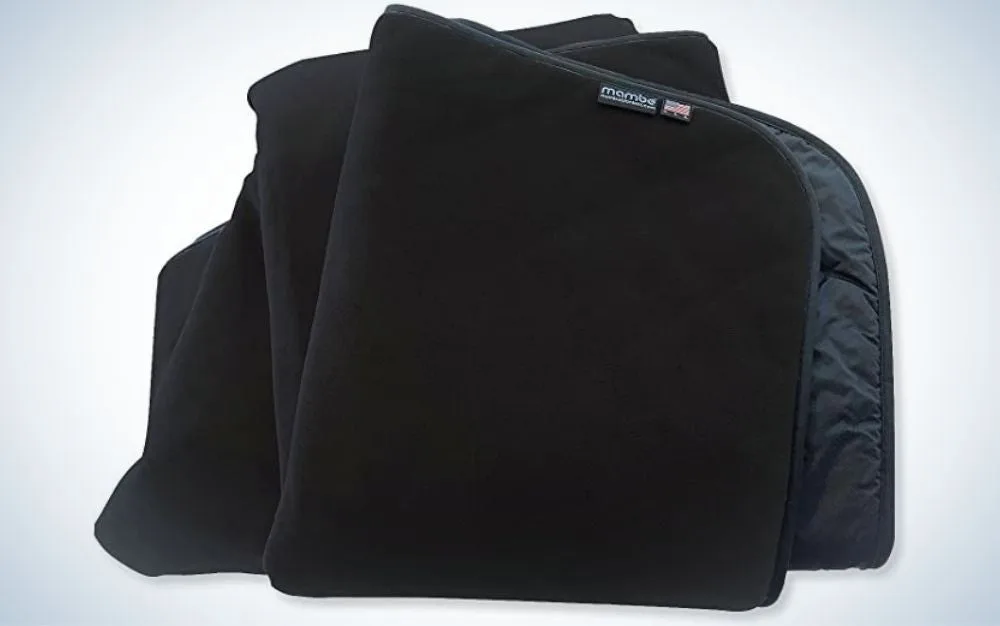
Why It Made The Cut: The Mambe Large Extreme Weather Outdoor Blanket is an excellent pick for a car survival kit or general outdoor blanket with ample insulation capabilities and easy-to-maintain materials.
Key Features
Weight: 6 lbs
Dimensions: 84″L x 58″W
Materials: Polartec classic 300 fabrics & Primaloft insulation
Heat Reflectivity: N/A
Pros
Machine washable
Versatile use
Waterproof and windproof
Heat reflective lining
Cons
Noisy materials
For an all-around car camping or car survival kit, the Mambe Large Extreme Weather Outdoor Blanket is hard to beat. It utilizes some properties of a traditional emergency blanket with a heat reflective lining while giving you a fleece blanket’s comfort and insulating properties.
It is very cozy, but it may prove to be too warm in some conditions. The wind and waterproof materials make this blanket perfect for outdoor activities and winter weather. One stand-out feature is that it is machine washable. Since the blanket is somewhat bulky, it works best in a washer with no agitator, and be sure to read care instructions carefully before washing or drying.
Like a mylar space blanket, this blanket’s main downfall is that it is noisy. One side of the blanket provides you with wind and waterproofing, and when moving around, it does make a crinkling noise that is likely to annoy some customers. Besides the noise factor, this is an excellent blanket not only for a car survival kit but also for general outdoor use.
How I Made My Picks
Choosing the best emergency blanket is not a one type fits all situation. Many high-performing and affordable options are available, but personal preference and intended use can influence your decisions. Beyond the materials and overall protection we detailed in the “things to consider before buying” section, we made our picks using criteria such as:
Durability: how long is the blanket expected to last? Can it hold up with use in an outdoor environment? Is there a warranty or a repair/replacement policy on the item?
Sustainability: what are the materials used to make the product? Is the company transparent about production practices? Can materials be reused, repurposed, or recycled? What is the product’s projected lifespan?
Customer Experience: do verified customers report positive experiences with the product and customer service representatives? Are customer inquiries answered in a timely manner? Does the company respond to questions about sustainability and production practices?
Other considerations when choosing our picks include some first-hand experience with products, company-specific research, and verified customer reviews.
FAQs
Q: How does a Mylar blanket keep you warm?
A Mylar blanket keeps you warm by reflecting body heat back to you. The material traps your body heat and can reduce heat transfer away from the body by up to 90%. Mylar has no insulating properties.
Q: How much does an emergency blanket cost?
How much an emergency blanket costs depends on the material, you seek. If the blanket is made of mylar or is a “space blanket” design, it will be relatively inexpensive ($5-30). Other types of emergency blankets made of fleece or wool material will be $20+ on average.
Q: Do emergency blankets actually work?
Yes, emergency blankets work. They are intended to keep you alive and avoid things like hypothermia. The best emergency blankets will help you retain at least 90% of your body heat by reflecting and trapping it under the material.
Q: What are emergency blankets made out of?
Traditional emergency blankets are made from metalized polyethylene or mylar, BoPET (biaxially-oriented polyethylene terephthalate)
. The differing materials reflect anywhere from 80-90% of radiated heat. Other emergency blankets can be made from things like polyester fleece or wool, but these materials insulate instead of reflecting heat.
Final Thoughts
The best emergency blankets will not only protect you when you need them, but they fit your intended use. While any survival kit can benefit from a mylar blanket, you may want something more versatile to keep in your car or to bring camping. Being prepared for anything when traveling, at home, or in the backcountry goes a long way. So make sure you have the best equipment to keep you safe, no matter the circumstances.

